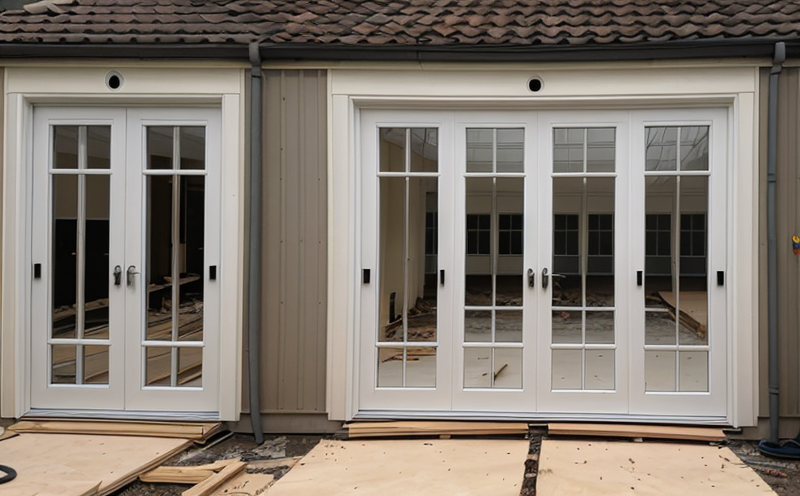Heat Flux Measurement through Fire Doors
In fire safety testing, heat flux measurement through fire doors is a critical aspect of ensuring that these components meet stringent performance requirements. Fire doors are designed to resist the passage of flames and smoke for specified periods under conditions of fire exposure. The heat flux through such doors plays a pivotal role in determining their effectiveness and compliance with relevant international standards.
Heat flux, defined as the rate of transfer of heat per unit area, is measured using specialized equipment that can accurately quantify how much thermal energy passes through the door during a fire event. This measurement helps to assess whether the door can maintain its integrity and function effectively under severe conditions. Proper heat flux measurement ensures that doors are not only resistant but also capable of mitigating the spread of fire within buildings.
The process involves subjecting the door to controlled fire exposures in accordance with relevant standards such as ISO 16733, which specifies test methods for determining the resistance of doors and frames to heat and flame. During testing, sensors are strategically placed on both sides of the door to capture the heat flux data accurately. This data is then used to evaluate the thermal performance of the door.
Understanding the heat flux through fire doors is essential for several reasons. First, it helps in assessing the door's ability to maintain structural integrity and prevent smoke and flames from spreading. Second, it ensures that the door meets stringent safety standards, thereby protecting lives and property. Finally, accurate measurement of heat flux contributes significantly to the overall design and optimization of fire-rated doors.
The importance of heat flux measurement cannot be overstated in the context of fire safety testing. By adhering to rigorous standards such as ISO 16733, laboratories can provide reliable data that supports the development and certification of high-performance fire doors. These doors are not only crucial for compliance with building codes but also play a vital role in enhancing public safety.
In summary, heat flux measurement through fire doors is a cornerstone of effective fire safety testing. It ensures that doors meet the necessary performance criteria under extreme conditions, thereby contributing to the overall safety and reliability of buildings.
Applied Standards
| Standard | Description |
|---|---|
| ISO 16733:2015 | Determines the resistance of doors and frames to heat and flame. |
| ASTM E968-14 | Methods for Determining Heat Transmission through Building Assemblies Using Guarded Hot Plate Apparatus. |
| EN 352-1:2017 | Determines the resistance of doors and frames to fire and smoke penetration in buildings. |
| IEC 60698-2-11:2014 | Methods for Determining Heat Transmission through Building Assemblies Using Infrared Thermometry. |
The application of these standards ensures that the heat flux measurement process is standardized and reliable, providing consistent results across different laboratories. This standardization is crucial for ensuring that fire doors meet the necessary performance criteria and can be trusted in critical environments.
International Acceptance and Recognition
The importance of accurate heat flux measurement through fire doors extends beyond mere compliance with local regulations; it also involves gaining international recognition. Laboratories that specialize in this area are often accredited to perform tests according to these standards, which are widely accepted across the globe. This accreditation not only enhances the credibility of the test results but also facilitates trade and collaboration between countries.
Many countries have adopted ISO 16733 as a benchmark for fire door testing due to its comprehensive approach and rigorous methodology. Similarly, ASTM E968-14 and EN 352-1:2017 are frequently used in North America and Europe respectively. IEC 60698-2-11 provides an alternative method using infrared thermometry, which is particularly useful for quick assessments.
By adhering to these international standards, laboratories can ensure that their heat flux measurement results are universally recognized and accepted. This global acceptance fosters trust among architects, engineers, and building owners who rely on these tests to make informed decisions about fire safety measures.
The widespread use of these standards also promotes consistency in testing protocols and equipment calibration, leading to more reliable and comparable data across different regions. This consistency is vital for ensuring that fire doors perform consistently under various environmental conditions worldwide.
Environmental and Sustainability Contributions
In addition to enhancing public safety, heat flux measurement through fire doors also contributes significantly to environmental sustainability efforts. Fire-resistant doors not only protect lives but also help reduce the spread of fires, which can minimize damage to structures and contents.
The use of high-performance fire doors can contribute to energy efficiency by reducing the need for extensive firefighting efforts after a blaze. This, in turn, leads to lower greenhouse gas emissions associated with rescue operations and subsequent reconstruction activities. Furthermore, sustainable manufacturing practices used in producing these doors help reduce waste and resource consumption.
By incorporating advanced materials and design techniques into fire door construction, manufacturers can create products that not only meet stringent safety standards but also contribute positively to environmental sustainability goals. For instance, the use of recycled materials or low-VOC paints reduces the carbon footprint associated with door production.
The integration of heat flux measurement into this process ensures that these doors are optimized for both fire resistance and energy efficiency. This dual focus on safety and sustainability represents a significant step towards creating more resilient and eco-friendly buildings.





